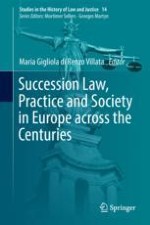2018 | OriginalPaper | Buchkapitel
The Ius Decretalium and the Development of the Law of Succession in Medieval Europe. Some Examples from Denmark and Sweden (XII–XIII C.)
verfasst von : Orazio Condorelli
Erschienen in: Succession Law, Practice and Society in Europe across the Centuries
Aktivieren Sie unsere intelligente Suche, um passende Fachinhalte oder Patente zu finden.
Wählen Sie Textabschnitte aus um mit Künstlicher Intelligenz passenden Patente zu finden. powered by
Markieren Sie Textabschnitte, um KI-gestützt weitere passende Inhalte zu finden. powered by
